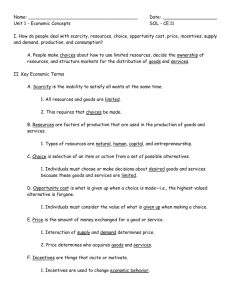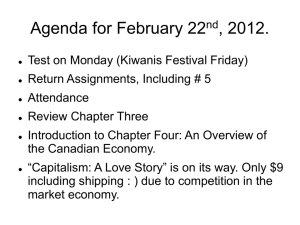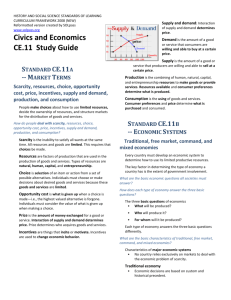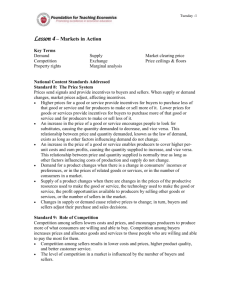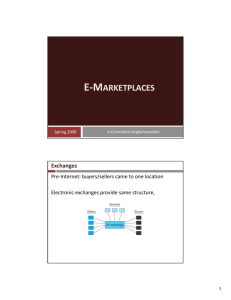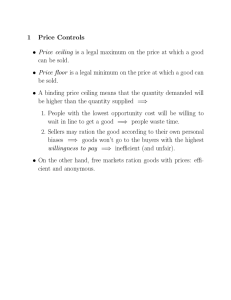LAWN BOY
advertisement
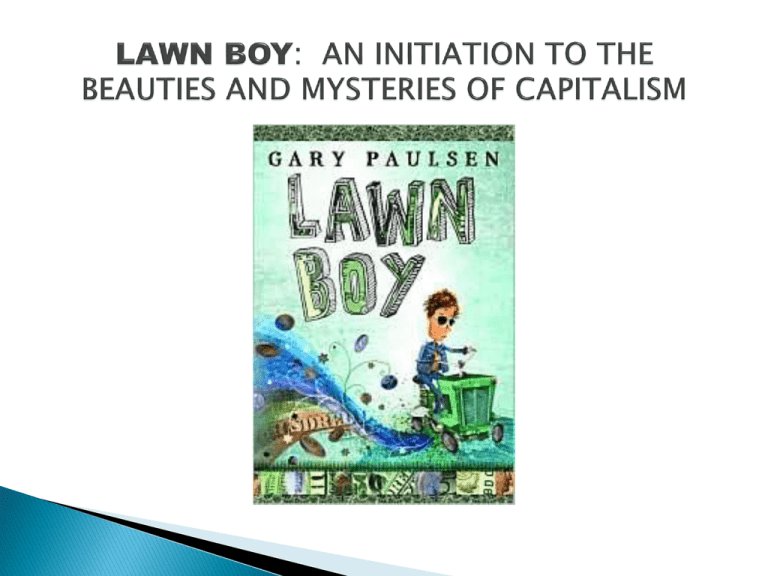
The student will understand the fundamentals of the market system. The student will understand the definition of Economics. The student will understand why people have to make choices and that with choosing comes consequences. The student will understand that with every benefit there is always a cost. Economics Scarcity Market Economy Opportunity Cost Entrepreneurship Incentives Supply Demand Price Benefits Costs Utility Labor Standard 1 : Scarcity Productive resources are limited. Therefore, people can not have all the goods and services they want; as a result, they must choose some things and give up others. Standard 2 : Marginal Cost/Benefit Effective decision making requires comparing the additional costs of alternatives with the additional benefits. Most choices involve doing a little more or a little less of something: few choices are "all or nothing" decisions. Standard 3 : Allocation of Goods and Services Different methods can be used to allocate goods and services. People acting individually or collectively through government, must choose which methods to use to allocate different kinds of goods and services. Standard 4 : Role of Incentives People respond predictably to positive and negative incentives 6-12, Knowledge in the Disciplines Content area teachers outside of the ELA classroom emphasize literacy experiences in their planning and instruction. Students learn through domain-specific texts in science and social studies classrooms – rather than referring to the text, they are expected to learn from what they read. Academic Vocabulary Students constantly build the vocabulary they need to access grade level complex texts. By focusing strategically on comprehension of pivotal and commonly found words (such as “discourse,” “generation,” “theory,” and “principled”) and less on esoteric literary terms (such as “onomatopoeia” or “homonym”), teachers constantly build students’ ability to access more complex texts across the content areas. Text-based Answers Students have rich and rigorous conversations which are dependent on a common text. Teachers insist that classroom experiences stay deeply connected to the text on the page and that students develop habits for making evidentiary arguments both in conversation, as well as in writing to assess comprehension of a text. A Cost is something you give up in making a choice A Benefit is something you gain. What would be the costs and the benefits of doing this now? Why have you chosen to do this instead? What are the costs and benefits? WHY MUST YOU CHOOSE? BECAUSE OF SCARCITY SCARCITY TELLS ME I CAN’T DO BOTH, I HAVE TO MAKE A CHOICE. SINCE YOU CAN’T HAVE EVERYTHING YOU WANT ECONOMICS HELPS US GET THE MOST OUT OF WHAT WE CAN HAVE. Have you ever heard the phrase: “There is no such thing as a free lunch”? EVEN THOUGH THE SIGN SAYS SO, IS IT TRULY FREE? I MAY NOT GIVE UP MONEY, BUT WHAT AM I GIVING UP BY ATTENDING? What is the Opportunity Cost of the following choice? Buying a gift for a friend. Working at a job after school. Waiting on line for an hour to buy a new cell phone. Playing on your X-Box for two hours after dinner. Did you all have the same answers? Why not? Economics is the study of how people make choices. When you make a good economic decision the benefits will be greater than the costs. He made a good decision He made a bad decision INCENTIVES are things such as rewards that motivate a person to do something. Punishment is meant to be a disincentive. WHY DO PEOPLE MAKE THE DECISION TO GO INTO BUSINESS FOR THEMSELVES? WHAT ARE THE INCENTIVES? PROFIT BE YOUR OWN BOSS FREEDOM FILL A NEED HAVE MORE CONTROL OVER MY WORK SCHEDULE PAID MORE FOR MY WORK BENEFITS GREAT CHANCE OF FAILURE NO ONE TO SHARE THE COSTS WITH NO ONE TO SHARE RESPONSIBILITIES OR SKILLS DO THE JOB OF THE WORKER AND THE BOSS COSTS THERE WAS A TIME WHEN THE MAJORITY OF ADULT AMERICANS SMOKED AND PEOPLE THOUGHT IT LOOKED COOL. WE GOT EDUCATED NOW LESS THAN 25% OF THE U.S. POPULATION SMOKES AND THE NUMBERS HAVE BEEN SHRINKING FOR DECADES. WHAT CHANGED? SCARCITY TELLS US WE CAN’T HAVE EVERYTHING WE WANT EVERY DAY OF OUR LIVES WE HAVE TO MAKE CHOICES IN MAKING CHOICES WE WEIGH THE BENEFITS AGAINST THE COSTS NOTHING IS FREE, THERE IS ALWAYS AN OPPORTUNITY COST A GOOD ECONOMIC DECISION CREATES MORE BENEFITS THAN COSTS INCENTIVES HELP US TO CHOOSE When the word MARKET is said, what are some examples or images that come to mind? FLEA MARKET STOCK MARKET FARMERS’ MARKET GROCERY STORE BOSTON MARKET WAL-MART HOUSING MARKET JOB MARKET Buyers arrive with money looking to purchase things. Sellers offer goods or services in exchange for money. What are some characteristics that all of these examples have in common? Buyers won’t be satisfied if they value the money in their pockets more that the items for sale. Sellers won’t be satisfied if they value the items for sale more than the buyers are willing to pay. Both buyers and sellers have an incentive to reach a compromise price in order to be mutually satisfied. THE WORLD’S ECONOMIES PROVIDE US WITH A LOT OF CHOICES AND THE WORLD’S SHOPPERS HAVE A LOT OF DIFFERENT INTERESTS. IN AMERICA, WE HAVE A LOT OF FREEDOM TO DECIDE WHAT WE WANT TO DO WITH OUR LIVES AND HOW WE WANT TO SPEND OUR MONEY SUPPLY DEMAND WHY DOES THIS GUY MAKE $30,000,000? WHY DOES THIS GUY MAKE $7.25? WE LOVE BASKETBALL, ESPECIALLY HIGH FLYING AND ACROBATIC DEFYERS OF GRAVITY ( HUGE DEMAND) THERE’S ONLY ONE LeBRON (TINY SUPPLY) WE LOVE FAST-FOOD THOUGH WE KNOW IT’S NOT GOOD FOR US (HUGE DEMAND) THERE ARE SEEMINGLY ENDLESS CHOICES FOR IT AND THE PROCESS OF MAKING IT DOESN’T REQUIRE UNIQUE SKILLS. JUST ABOUT ANYONE CAN FILL THE JOB. ( EVEN BIGGER SUPPLY) It’s the Motorola DynaTAC 8000X , the world’s first cell phone. It went on sale March 6, 1983 and the initial price was $3995 ($9322 in current dollars). It had enough battery life for 30 minutes of talk, its memory could store 30 phone numbers, and there was a waiting list of thousands anxious to buy it. Today we have cellular technology that allows for all kinds of communication, video streaming, and downloads with more computing power and memory then the technology that sent all of our astronauts to the Moon. Many are given away with service contracts. HOW DID THAT HAPPEN? IN 1983, ONE COMPANY MADE CELL PHONES WITH VERY EXPENSIVE PARTS AND A GREAT AMOUNT OF COSTLY LABOR (TINY SUPPLY) PEOPLE WERE CRAZY ABOUT IT AND WAITED FOR MONTHS BEFORE DELIVERY (BIG DEMAND) IN 2011, MANY COMPANIES MAKE A VARIETY OF PHONES WITH VERY INEXPENSIVE PARTS AND VERY LITTLE HUMAN LABOR INVOLVED (HUGE SUPPLY) MOST CONSUMERS HAVE A PHONE AND SPEND MOST OF THEIR MONEY ON SERVICES (DEMAND IS SLOWING DOWN) 1. 2. 3. 4. 5. A TICKET TO SEE YOUR FAVORITE FOOTBALL TEAM NOW THAT THEY’VE MADE THE PLAYOFFS A GALLON OF GASOLINE AFTER A HURRICANE SHUTS DOWN OIL DRILLING PLATFORMS IN THE GULF OF MEXICO. A BUSHEL OF CORN AFTER FARMERS IN IOWA DISCOVER A MORE POWERFUL FERTILIZER. A PAIR OF DESIGNER JEANS AFTER EVERYONE’S FAVORITE CELEBRITY IS SEEN WEARING THEM THE NIGHT BEFORE ON AN AWARDS SHOW. A BIG MAC AFTER RESEARCHERS DETERMINE THAT EATING TOO MUCH FAST FOOD CAUSES STUDENTS TO GET LOWER GRADES. IN ORDER FOR THE MARKET TO WORK IT MUST BE OPEN TO EVERYONE MARKETS ARE CREATED TO ALLOW BUYERS AND SELLERS TO PROFIT. SELLERS MAKE MONEY AND BUYERS GET THE ITEMS THEY’RE LOOKING FOR. THE PRICE HELPS BUYERS MAKE DECISIONS ON WHAT THEY WILL PURCHASE AND HELPS SELLERS DETERMINE WHAT THEY SHOULD PRODUCE. WAGES ARE DETERMINED BY THE SUPPLY AND DEMAND FOR THE JOB SKILLS OFFERED.

